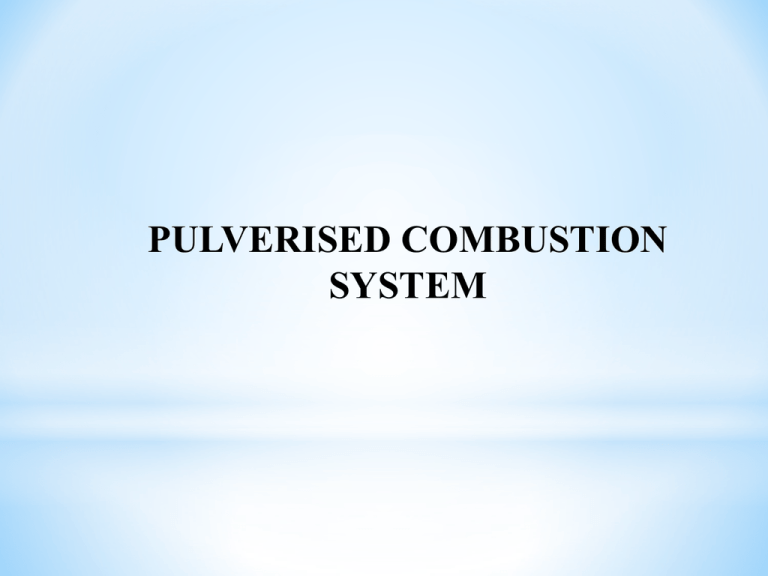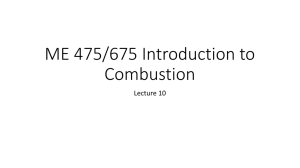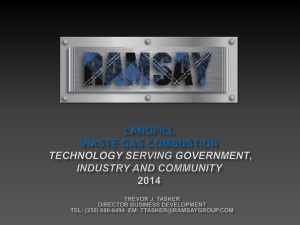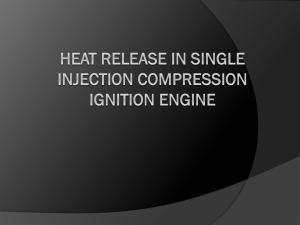Combustion - Power Industry
advertisement

PULVERISED COMBUSTION SYSTEM PULVERISATION FUELS COAL COAL APPLICATIONS COAL COMBUSTION COMBUSTION OF FUELS- SOLID, LIQUID & GAS EMERGING TRENDS Nox FORMATION AND CONTROL Coal dust is a fine powdered form of coal More surface area per unit weight than lumps of coal More susceptible to spontaneous combustion Pulverised coal has significant dust explosion hazard FUELS Solid Fuels Coal Peat Lignite Bituminous Anthracite Liquid Fuels HSD LFO HFO Gaseous Fuels BFG Producer Gas LPG Natural Gas Proximate Analysis Ultimate Analysis COAL C 40-90% H 2-7% O <18-30% S <6% N 1-5% Char 20-70% Ash 5-45% H2O 2-20% VM 15-30% Heterogeneous organic fuel formed mainly from decomposed plant matter. Over 1200 coals have been classified. Coalification forms different Coal Types: Peat Lignite Bituminous coal Anthracite Evolution Time, Pres.&Temp. Coal Rank Home – heating and cooking Transportation – steam engines Industry – Iron & steel Electricity – power plants COMBUSTION Oxidation oxygen combines with other elements and forms oxidies. Combustion, A special form of oxidation Oxygen combines with fuels; coal, oil, gas substantial amounts of heat is liberated. The Degree of Flammability depends convertibility to a gas,-nothing truly burns until it is a gas. Nature of fuel Quantity of the fuel, Stages of Combustion Ignition Combustion Stability Completion of Combustion Combustion process, ignition occurs in vapour phase. Solid and liquid fuels get ignited from their vapours. Combustion Stability: Ignited flame shall be sustained further so that the process of combustion would be continuous. Completion of Combustion: Fuel staying for the minimum period (residence time) Completely oxidizing the combustible. Considerations of combustion: Safety consideration during fuel handling Generation of Pollutants viz. Nox and Sox . volatiles homogeneous combustion CO2, H2O, … coal particle p-coal, d=30-70m char heterogeneous combustion CO2, H2O, … devolatilization tdevolatile=1-5ms tvolatiles=50-100ms tchar=1-2sec t Combustion of Fuels in furnace Preparing the fuel and air ; Converting the complex fuel into elementary fuels; Right fuel and air mixture Transferring heat from the products of combustion to the boiler or other surfaces. The physical processes influencing pulverized coal combustion Turbulent/Swirling flow of air and coal. Turbulent/Convective/molecular diffusion of gaseous reactants and products. Convective heat transfer through the gas and between the gas and coal particles. Radiative heat transfer between the gas and coal particles and between the coal/air mixture and the furnace walls. COMBUSTION OF DIFFERENT FUELS Solid Fuel Volatile matter is released over a temp. of 250 - 900 deg. C. The volatile matter is first ignited. The coal particle upon releasing the volatile matter become a char. The char slowly burns out. Liquid Fuel Boils and releases volatile matter and gets ignited The balance char completes the combustion. COAL - AIR BALANCING IN FUEL PIPING Un balance in Coal- air flow into the furnace results uneven heat release uneven distribution of excess air unpredictable Nox formation Remedies Selection of Orifices for Coal air two phase flow regime. Provision of on -line adjustment dampers in coal air flow path. On-line measurement of coal -air flow using microwave OIL FIRING SYSTEM FEATURES Fuel Oil Preparation Pumping the oil and heating it are the major preparatory functions. Filtration of oil to remove any dust, dirt, sediments, sledge etc. This renders long trouble free service life to pumps, valves, atomisers etc Maintaining the HFO temperature constant, corresponding to the atomizing viscosity of 15 to 20 centistokes, is essential for better fuel oil atomization. A lower temperature of fuel oil impairs the burner performance and a higher temperature causes oil cracking. Fuel Oil Atomisation Atomisation spraying the fuel oil into fine mist Better mixing of the fuel with the combustion air Pressure and viscosity influence atomisation Pressure energy of the steam to velocity energy, which breaks up the oil stream into fine particles Poorly atomisation results in Bigger spray particles Longer burning time Carryovers of carbon and flame instability due to low rate of heat liberation Incomplete combustion and smoke Oil Recirculation To warm up the oil supply lines To maintain correct atomising temperature System Vents Fuel oil heaters Oil strainers oil & steam lines - get rid of air locks. System Drains Oil lines with a drain valve at the lowest point. BURNERS: To deliver coal , oil and air in a proper proportion To facilitate ignition energy to the coal air stream To sustain the ignition To provide a stable flame during the operation Types of Burners Tangential Burners Wall Burners, Ex: Low Nox R burners Down shot or fan tail burners Modern Burners are equipped with: Separate flame envelope ports for coal, oil and gas Secondary air control to adjust the flame envelops Ignitors Flame Scanners - detect the distinct flames in an enclosure Flame Stabilisers Flame Analysers Burner Arrangement Tangential firing: Four tall windboxes (combustion air boxes) one at each corner of the furnace. The oil and gas burners are located at different levels or elevations of the windboxes. The coal , oil and gas burners are sandwiched between air nozzles or air compartments. That is, air nozzles are arranged between gas spuds, one below the bottom gas spud and one above the top gas spud. Burner Tilt: The burners are tiltable +/- 30o about horizontal, To shifts the flame zone across the furnace height To control over steam temperature Combustion Air Distribution The Combustion air Primary Air (PA) and Secondary Air (SA) Secondary Air(SA) provided from FD Fans Primary Air(PA) provided from PA Fans Ignitors Oil and gas are ignited by a pilot flame. Type of Ignitors Oil ignitor Gas ignitor High Energy Arc ( HEA) ignitor Flame Sensing Devices Flame sensing devices are broadly grouped in to Infrared flame sensors UV flame scanners Visible light scanners Recent development Flame analysers for multiple fuels Emissions of Combustion - Pollutants 1. Nox emission 2. Sox emission 3.CO 2 emission (Green House Gases) 4. CO emission 5. Particulate emission Emerging Trends in combustion system Design Emerging trends in combustion system Design Multiple fuel Burners Low Emission Burner - Technology development Longer guarantee period for high ash coals - Material selection, - Improved design features New devices such as thermal analysers., Emerging trends in combustion system Design Cont.…… Micro processor based on line measurement and control Computer simulations using software tools viz., ANSYS, CFD. Virtual assembly using CAD tools NOx Formation and Control Strategies NOX FORMATION Thermal NOx Formation Nox Formation from Fuel Nitrogen NOx Control options Control Technique NOx Reduction Potential(%) Over fire air (OFA) 20-30 Low Nox Burners (LNB) 35-55 LNB + OFA 40-60 Re-burn 50-60 SNCR ( Selective Non Catalytic Reduction) 30-60 SCR (Selective Catalytic Reduction) LNB with SCR 75-85 LNB with OFA and SCR 85-95 50-80 Selective Catalytic Reduction (SCR) Reactions 4 NO 4 NH 3 O2 4 N 2 6 H 2O TiO2 or V2 O5 supported catalyst or V2O5 supported catalyst 2 NO2 4 NH 3 O2 TiO 2 3N 2 6 H 2O AVAILABLE TECHNIQUES FOR REDUCING NOX FROM TANGENTIAL COAL FIRED UNITS 90 SCR % NOX REDUCTION FROM BASE * 80 PM+ NH3/UREA 70 PM 60 CCTFS 50 LNCFS W/OFA 40 30 CLOSE COUPLED OFA 20 10 0 INCREASING COST * BASE IS A TYPICAL PRE 1970 TANGENTIALLY FIRED UNIT. BASE NOX OVER FIRE AIR (OFA) Through additional air compartments, to handle 15 percent of total wind box air flow. Inhibits formation of both fuel Nox and thermal Nox as an Oxygen Deficient environment is established in the primary combustion zone 20 to 30% reduction in Nox formation NOX DEPENDENCE ON OVERFIRE AIR FLOW 350 300 NO (PPM @ 3% O2) 250 OFA VS NO 200 150 EXCESS O2 (%) VS NO 100 50 0 0 2 4 6 8 OVERFIRE AIR(%) 10 12 14 16 While Nox emission decrease linearly with increasing over fire air, Excess air rises (i.e., More Air Is Needed To Complete The Combustion). If over fire air is increased beyond 15%. This decreases boiler efficiency due to the heating of extra air Nox Reduction Techniques STAGED COMBUSTION: Fuel Bound Nitrogen to be regulated High-Temperature Formation must be curtailed. Withholding of Some O2 from primary flame zone Air staging LOW NOx BURNERs Wall burners (oil and gas firing ) Low NOx R-burner is capable of emitting NOx at a level of 150 ppm on oil firing. Tangential firing ( Coal firing) CCOFA(Close Coupled Over Fire Air) feature. Separate Over Fire Air( SOFA ) . THANK YOU ALL







